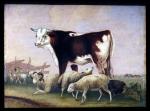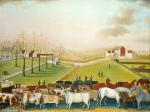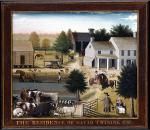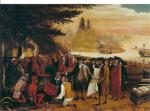![header=[Marker Text] body=[Famed primitive artist. His subjects included farmscapes and Biblical scenes; he painted more than fifty versions of The Peaceable Kingdom, based on a prophecy of Isaiah. Also a coach and sign painter; a Quaker preacher. Lived here on Penn Street, 1821-49.] sign](http://explorepahistory.com/kora/files/1/10/1-A-41-139-ExplorePAHistory-a0a5c7-a_450.gif)
Mouse over for marker text
Name:
Edward Hicks [Agriculture]
Region:
Philadelphia and its Countryside/Lehigh Valley
County:
Bucks
Marker Location:
122 Penn St., Newtown
Dedication Date:
September 6, 1997
Behind the Marker
In October 1846, James Cornell's prize bull took the premium at the annual livestock exhibit of the Bucks County Agricultural Society, a group he had helped found. To commemorate his triumph, Cornell commissioned a painting by sixty-nine-year-old Edward Hicks, a local Quaker lay minister, sign painter, and artist who had earned a regional reputation painting historical subjects, and regional farmscapes. In the preceding years, the aging minister had painted a series of farmscapes, including an 1845 canvas of the Hillborn farm as he recalled it in 1821, and four paintings of the David Twining farmstead as Hicks remembered it living there as a small child in the 1780s.
Accepting the Cornell commission, Hicks created another memorable composition. In it he painted Cornell's prosperous and neatly ordered farm with its large stone farmhouse, massive white barn, freshly painted outbuildings, cribs filled with corn, and rolling tree-covered hills in the background. In the foreground one sees handsome and healthy cows, horses, swine, and sheep. Behind them, farmers in pairs discuss which should win the prizes. In his Indian Summer view of the Farm and Stock of James C. Cornell, Hicks captured the orderliness, simplicity, and richness of the southeast Pennsylvania farm.
In 1849, when the frail artist was nearing death, Hicks painted the Leedom Farm with its well-ordered buildings, fat and healthy livestock, and the wooded hills of Bucks County in the background. Today, Hicks's farm paintings remain some of the most beautiful and timeless images of the order, simplicity, prosperity, and harmony between man and nature that always existed on the Pennsylvania farm more in imagination than the real world. This idealized image of the American farm and others like it would fuel the imagination of generations of Americans who envisioned the United States as a land of prosperous, self-sufficient family farmers; a people who exercised their God-given dominion over nature with wisdom and forbearance.
Hicks's was a vision shared by Virginia planter Thomas Jefferson, and Pennsylvania Congressman Galusha Grow, who dreamed that free land awarded by the Homestead Act of 1862 would fill the American West with farms modeled after those of his Pennsylvania childhood. It also was shared by the generations of farm families who joined the
Galusha Grow, who dreamed that free land awarded by the Homestead Act of 1862 would fill the American West with farms modeled after those of his Pennsylvania childhood. It also was shared by the generations of farm families who joined the  Pennsylvania Grange, and by the farmers and planners who established the
Pennsylvania Grange, and by the farmers and planners who established the  Honey Hollow Agricultural district as a model of sustainable rural life for the nation in the 1930s.
Honey Hollow Agricultural district as a model of sustainable rural life for the nation in the 1930s.
One of the greatest painters of the Early Republic, Edward Hicks was born to Catherine and Isaac Hicks on April 4, 1780 in Attleborough (present-day Langhorne), Pennsylvania. A prosperous official for the British Crown, "Squire" Isaac Hicks lost so much during the American Revolution that he was forced, after his wife Catherine died in 1781, to send his four children to live with kinsmen and friends. (This common process was then known as "farming out.") Hicks gave his infant, Edward, to Quakers David and Elizabeth Twining to be raised on their farm.
Apprenticed to a carriage maker at the age of thirteen, Edward as a young man joined the Religious Society of Friends as a member of the Middletown Meeting and, in 1803, married Sarah Worstall. In 1811, he opened his own coach and sign painting shop in Newtown and became a Quaker lay minister, traveling, often great distances, to bring the word of God to other meetings.
Hicks's decorative artwork won him clients and led him into "fine work"; that is, canvasses that he painted on religious and historical subjects in a "plain" Quaker style. But these "impractical" art works also earned him condemnation from many in his meeting who claimed that his paintings violated the Quaker doctrine of plainness and simplicity. In 1815, Hicks gave up his coach shop and painting to become a farmer, but the intensive physical exertion aggravated his chronic respiratory problems, so in 1817, he returned reluctantly to his studio.
returned reluctantly to his studio.
In the following decades the traveling minister painted canvasses of Noah's Ark, William Penn's Treaty with the Indians, Washington Crossing the Delaware, Niagara Falls, the farms of southeast Pennsylvania, and his Peaceable Kingdom - allegorical paintings of a small child among wild and domesticated animals that reflected the Quaker preacher's belief in mankind's ability to live in peaceful coexistence with God's creatures. Edward Hicks died in Newtown, Pennsylvania on August 23, 1849.
To learn more about Hick's as a painter click here.
here.
"Look nature through,'tis neat gradation all. By what minute degrees her scale ascends! Each middle nature joined at each extreme, To that above it joined, to that beneath!"
Edward Hicks, "Goose Creek Sermon," 1837.
In October 1846, James Cornell's prize bull took the premium at the annual livestock exhibit of the Bucks County Agricultural Society, a group he had helped found. To commemorate his triumph, Cornell commissioned a painting by sixty-nine-year-old Edward Hicks, a local Quaker lay minister, sign painter, and artist who had earned a regional reputation painting historical subjects, and regional farmscapes. In the preceding years, the aging minister had painted a series of farmscapes, including an 1845 canvas of the Hillborn farm as he recalled it in 1821, and four paintings of the David Twining farmstead as Hicks remembered it living there as a small child in the 1780s.
Accepting the Cornell commission, Hicks created another memorable composition. In it he painted Cornell's prosperous and neatly ordered farm with its large stone farmhouse, massive white barn, freshly painted outbuildings, cribs filled with corn, and rolling tree-covered hills in the background. In the foreground one sees handsome and healthy cows, horses, swine, and sheep. Behind them, farmers in pairs discuss which should win the prizes. In his Indian Summer view of the Farm and Stock of James C. Cornell, Hicks captured the orderliness, simplicity, and richness of the southeast Pennsylvania farm.
In 1849, when the frail artist was nearing death, Hicks painted the Leedom Farm with its well-ordered buildings, fat and healthy livestock, and the wooded hills of Bucks County in the background. Today, Hicks's farm paintings remain some of the most beautiful and timeless images of the order, simplicity, prosperity, and harmony between man and nature that always existed on the Pennsylvania farm more in imagination than the real world. This idealized image of the American farm and others like it would fuel the imagination of generations of Americans who envisioned the United States as a land of prosperous, self-sufficient family farmers; a people who exercised their God-given dominion over nature with wisdom and forbearance.
Hicks's was a vision shared by Virginia planter Thomas Jefferson, and Pennsylvania Congressman
One of the greatest painters of the Early Republic, Edward Hicks was born to Catherine and Isaac Hicks on April 4, 1780 in Attleborough (present-day Langhorne), Pennsylvania. A prosperous official for the British Crown, "Squire" Isaac Hicks lost so much during the American Revolution that he was forced, after his wife Catherine died in 1781, to send his four children to live with kinsmen and friends. (This common process was then known as "farming out.") Hicks gave his infant, Edward, to Quakers David and Elizabeth Twining to be raised on their farm.
Apprenticed to a carriage maker at the age of thirteen, Edward as a young man joined the Religious Society of Friends as a member of the Middletown Meeting and, in 1803, married Sarah Worstall. In 1811, he opened his own coach and sign painting shop in Newtown and became a Quaker lay minister, traveling, often great distances, to bring the word of God to other meetings.
Hicks's decorative artwork won him clients and led him into "fine work"; that is, canvasses that he painted on religious and historical subjects in a "plain" Quaker style. But these "impractical" art works also earned him condemnation from many in his meeting who claimed that his paintings violated the Quaker doctrine of plainness and simplicity. In 1815, Hicks gave up his coach shop and painting to become a farmer, but the intensive physical exertion aggravated his chronic respiratory problems, so in 1817, he
In the following decades the traveling minister painted canvasses of Noah's Ark, William Penn's Treaty with the Indians, Washington Crossing the Delaware, Niagara Falls, the farms of southeast Pennsylvania, and his Peaceable Kingdom - allegorical paintings of a small child among wild and domesticated animals that reflected the Quaker preacher's belief in mankind's ability to live in peaceful coexistence with God's creatures. Edward Hicks died in Newtown, Pennsylvania on August 23, 1849.
To learn more about Hick's as a painter click









